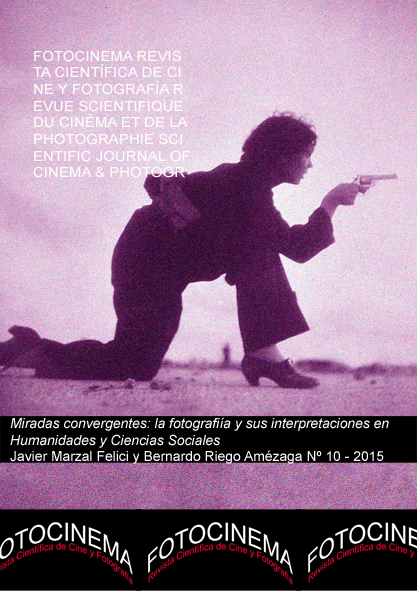De la criminalidad a la santificación. Sentidos e identidades inestables en la fotografía de Isidro Velázquez (Argentina)
DOI:
https://doi.org/10.24310/Fotocinema.2015.v0i10.5990Abstract
Resumen:
Este trabajo surge de la discusión sobre la identidad inestable de la fotografía, la fijación provisoria de sus sentidos y la mutación de los mismos a partir de la circulación/recepción de la imagen en diversos medios y altares populares. Las relaciones entre control y vigilancia de la imagen que muta a icono relacional se realiza a través del análisis de un caso de relevancia en Argentina: el de Isidro Velázquez, quien fuera considerado en la década de 1960 como “gaucho rebelde” o “bandido rural” por el establishment, mientras otra parte de la sociedad lo valoraba como un “Robin Hood” regional. El Nordeste argentino fue el ámbito de acción de este personaje, y el proceso de su criminalización por unos y de mitificación por otros estuvo nutrido por representaciones fotográficas en algunos casos compartidas por los distintos sectores. En este marco, debatimos sobre el carácter mimético de estas fotografías, el efecto de realidad, la imagen como prueba-verdad, como sustituto y símbolo. Las dimensiones significantes de la imagen son analizadas en relación a la inserción de las fotos en diversas prácticas discursivas e institucionales, en santuarios populares y en la producción audiovisual “Isidro Velázquez, la leyenda del último Sapucay” (2010).
Abstract:
This paper discusses the unstable identity of photography, the eventual binding and mutation of its senses when the image circulates from altar to altar, and from media to media. The relationship between control and surveillance of the image which turns into a relational icon is carried out through the analysis of a rebellious gaucho who lived during the 60s in Argentina. He was “Isidro Velázquez”, considered a “rural outlaw” by the establishment while other part of the society considered him a regional “Robin Hood”. Isidro Velázquez acted in the Northeast of Argentina. The process of becoming a criminal on the one hand and myth on the other was nurtured by photographic representations in some cases shared by the different sectors. We discuss the mimetic character of these photographs, the effect of reality, the image as proof, as a substitute and as a symbol. The significant dimensions of image are studied in relation to the insertion of these photos in institutional and discourse practices in popular contemporary sanctuaries and the audiovisual production “Isidro Velázquez, la leyenda del último Sapucay” (2010).
Palabras clave:
Fotografía; identidad; representación; recepción; Argentina
Keywords:
phtography; identity; representation; reception; ArgentinaDownloads
Metrics
Publication Facts
Reviewer profiles N/A
Author statements
Indexed in
-
—
- Academic society
- N/A
- Publisher
- Universidad de Málaga
Downloads
Published
How to Cite
Issue
Section
License
All contents published in Fotocinema Revista científica de cine y fotografía are protected under the Creative Commons Attribution-NonCommercial-ShareAlike 4.0 International (CC BY-NC-SA 4.0) license. All about this license is available in the following link: <http://creativecommons.org/licenses/by-nc-sa/4.0>
Users can copy, use, redistribute, share and exhibit publicly as long as:
- The original source and authorship of the material are cited (Journal, Publisher and URL of the work).
- It is not used for comercial purposes.
- The existence of the license and its especifications are mentioned.
There are two sets of authors’ rights: moral and property rights. Moral rights are perpetual prerogatives, unrenounceable, not-transferable, unalienable, imprescriptible and inembargable. According to authors’ rights legislation, Fotocinema. Revista científica de cine y fotografía recognizes and respects authors moral rights, as well as the ownership of property rights, which will be transferred to University of Malaga in open access. The property rights are referred to the benefits that are gained by the use or the dissemination of works. Fotocinema. Revista científica de cine y fotografía is published in an open access form and it is exclusively licenced by any means for doing or authorising distribution, dissemination, reproduction, , adaptation, translation or arrangement of works.
Authors are responsable for obtaining the necessary permission to use copyrighted images.














13.png)



